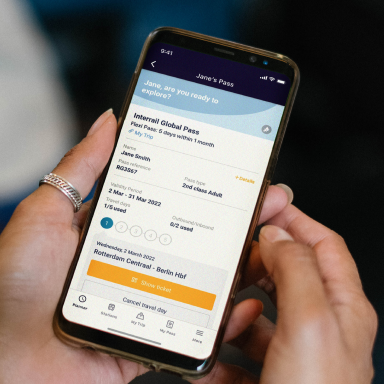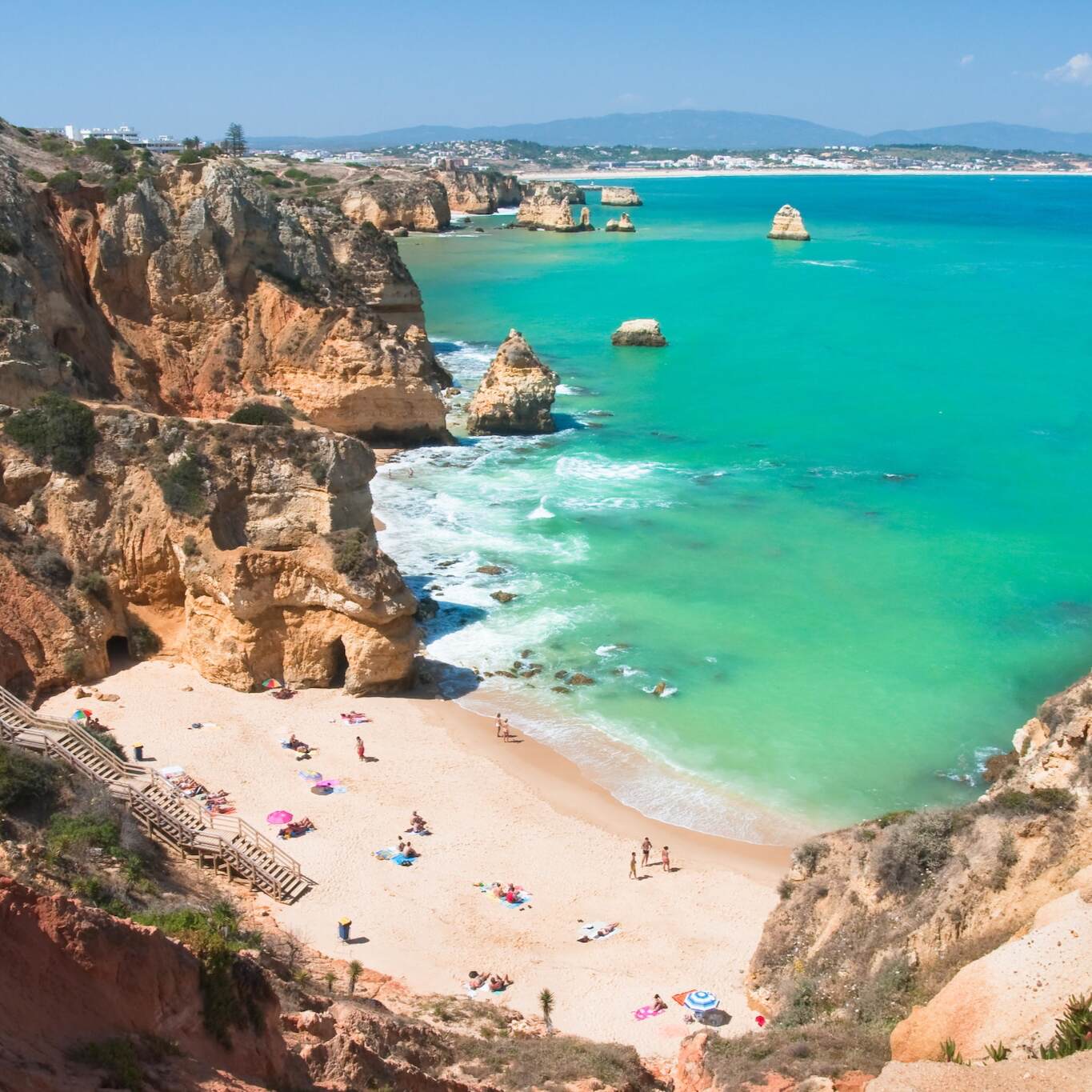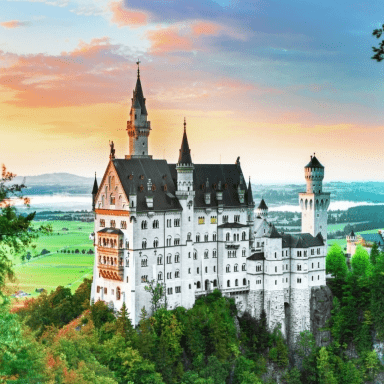

Next stop: Germany
2-week itinerary through Germany's biggest cities
Germany is a big country brimming with history, culture and nature, and one of the best ways to discover it is by rail. The German railway system is very well-developed, reliable and punctual. You can enjoy watching the spectacular landscapes of valleys and castles stream past your window, then arrive at vibrant city destinations. Travel restrictions and lockdown measures are in place in Germany (as of April 2021). But as soon as you can travel freely, grab your German Rail Pass and follow us on this adventure. You'll see that Germany is so much more than bratwurst and beer!
Places visited in Germany
This itinerary starts in Berlin, which is easily accessible by plane, train or car.
1. Berlin
2. Hamburg
3. Dortmund
4. Cologne
5. Frankfurt
6. Heidelberg
From Heidelberg, you can go to bigger cities like Munich or Frankfurt, from where you can continue your rail trip or head back home.

1. Berlin
There's a big chance that you’ll kick off your trip in Berlin. The capital of Germany is a city full of history and rich in astonishing architecture, making it one of the most interesting places to visit in Western Europe. Being at the epicentre of many of the most significant events in the 20th Century - from WWI and WWII to the Cold War - Berlin has been at the very core of the mall.
Take your time to visit some of the most well-known spots in Berlin, like the Reichstag, the Brandenburg Gate, and the Memorial to the Murdered Jews of Europe, one of the most thought-provoking places in the city. Experience the glorious Berlin Cathedral, discover art at the Berlin Wall East Side Gallery and gorge on the diverse foods of the city!
Fun fact: Did you know you can easily figure out which part of the city you are in – East or West Berlin? Take a look at the tram tracks! They were abolished in West Berlin after reunification and replaced by the underground system we know today. If you can find tram tracks, you are indeed in East Berlin.

2. Hamburg
Hamburg is the second largest city in Germany, a port dotted with boats and sprinkled with quaint cafes and restaurants. The astonishing architecture, encompassing parklands and a wide variety of museums, make this city worth wandering around and exploring.
The only part of Hamburg that survived centuries of fires and wars is Deichstraße street, which gives a sense of the city's past. Deichstrasse takes you straight onto a bridge over one of the city's many canals and into the regenerated Speicherstadt. Here are massive brick warehouses that form a canyon along the canal's sides.
Stroll along to the City Hall (or Rathaus) and head to the wide Mönckebergstraße, Hamburg's principal shopping and business district, which will lead you to St. Peter's Church, a cathedral and fine example of brick Hansa architecture, notable for its 133- metre belltower. Looking for a nightlife vibe? Head to Reeperbahn, Hamburg's rambunctious red light district, full of nightclubs, bars and discos.
Fun fact: Men from Hamburg are called Hamburgers, and women from there are called Hambergerins!

3. Dortmund
Dortmund is one of the most dynamic and green cities in Germany. The former capital of the metal industry is today a high-tech manufacturing city and many of its spaces are parks and gardens.
If you are visiting Dortmund, you will come across the Alter Markt (The Market Square), at the heart of the historic centre, which has been the place used by merchants to do business. Stroll around its small but pleasant old town, where you will find hundreds of shops of all kinds, surrounded by many historical buildings. One of the most important monuments of the city is the Church of Saint Reinold’s, dedicated to Renaud de Montauban, the patron saint of the city of Dortmund.
Beyond German borders, the city is known for its football team. Whether you like football or not, we highly recommend the German Football Museum, where you will learn about not only the history of football in the country but also its importance of it from an economic, social and cultural perspective.

4. Cologne
Cologne is the fourth most important city in Germany, famous for its cathedral, a gothic gem that survived the bombings of WWII and can now be seen from almost every corner of the city.
One of the best things to do in Cologne is wandering the streets of its historic centre. Here you will come across numerous fountains, monuments and colourful traditional houses turned into boutiques, art galleries, cafes and restaurants. Don't miss the Kölner Rathaus, known for being the oldest town hall in Germany. Then head to the banks of the Rhine river to enjoy the beautiful views of the city.
Also, keep an eye out for all the street art around town. From large murals on facades to small details on doors and lamp posts… the creativity of the artists is endless!

5. Frankfurt
Located in the heart of Germany, Frankfurt is the largest financial centre in continental Europe.
What makes Frankfurt so unique is its harmony and fusion of a modern, cutting-edge city with a fascinating and welcoming historic centre. As you wander around, you will be able to find a wide amount of museums and art galleries, as well as important medieval buildings.
Any visit to Frankfurt should start with the medieval Römerberg square, the heart of the old city (Altstadt). In the centre of the square stands the Fountain of Justice, "Gerechtigkeitsbrunnen", with the sculpture of the Goddess blindfolded and with a sword in hand.
If you are a fan of literature, you should stop at the Goethe House Museum, where Goethe lived until the age of 16. Although the house was destroyed in World War II, it has been fully restored with the original furniture, paintings, and books belonging to the family.
You can also explore the MMA (Museum of Modern Art), the Old Church of San Nicolás or stroll through the Sachsenhausen district, one of the most picturesque neighbourhoods in the city.
Interesting fact: There are 15 skyscrapers in Germany, out of which 14 are in Frankfurt.

6. Heidelberg
A charming city with a historical reputation for being the seat of the first university in Germany (which was founded in 1386), Heidelberg has a special atmosphere. Hundreds of students and tourists cheer up its streets every day, full of monuments and attractions of great historical value. The heart of the old town is the hectic Hauptstraße, a long pedestrian street lined with bars, restaurants, shops and beautiful medieval buildings.
Check out the Student Jail (Studentenkarzer) and the magnificent Marktplatz, the main square in the historic centre, where you will come across the City Hall building and the Church of the Holy Spirit (Heiliggeistkirche). And if you need to wind down, take a short cruise along the banks of the city in a solar-powered boat through the Neckar River.
Last but not least, head to Heidelberg Castle, a huge architectural complex of great historical value and incalculable beauty. Perched on the Königstuhl hill (200 meters high!), the castle offers spectacular views of the river and the city centre.
Fun fact: Inside the Castle you can find the largest wine barrel in the world, the Heidelberg ‘Tun’, with an astounding capacity of 220,00 litres.

You might like this as well:
-
![italy-rome-navona-square]() Two Weeks In Italy By Train Planning the ultimate two-week itinerary in Italy? Ride the rails on local or high-speed trains with an Interrail Pass to see more & experience the Italian way of life.
Two Weeks In Italy By Train Planning the ultimate two-week itinerary in Italy? Ride the rails on local or high-speed trains with an Interrail Pass to see more & experience the Italian way of life. -
![italy-florence-ponte-vecchio-arno-river]() Switzerland And Italy In Two Weeks Do you want to visit Switzerland and Italy by rail? With some of the best scenic routes in Europe, we have the ultimate two-week itinerary for you.
Switzerland And Italy In Two Weeks Do you want to visit Switzerland and Italy by rail? With some of the best scenic routes in Europe, we have the ultimate two-week itinerary for you.
Change of currency
You cannot change the currency once you have a Pass in your cart. Remove the Pass, and then change the currency on the website header.








